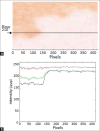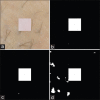Objective Assessment of Skin Repigmentation Using a Multilayer Perceptron
- PMID: 31316902
- PMCID: PMC6601228
- DOI: 10.4103/jmss.JMSS_52_18
Objective Assessment of Skin Repigmentation Using a Multilayer Perceptron
Abstract
Background: Vitiligo is a pathology that causes the appearance of achromic macules on the skin that can spread on to other areas of the body. It is estimated that it affects 1.2% of the world population and can disrupt the mental state of people in whom this disease has developed, generating negative feelings that can become suicidal in the worst of cases. The present work focuses on the development of a support tool that allows to objectively quantifying the repigmentation of the skin.
Methods: We propose a novel method based on artificial neural networks that use characteristics of the interaction of light with the skin to determine areas of healthy skin and skin with vitiligo. We used photographs of specific areas of skin containing vitiligo. We select as independent variables: the type of skin, the amount of skin with vitiligo and the amount of repigmented skin. Considering these variables, the experiments were organized in an orthogonal table. We analyzed the result of the method based on three parameters (sensitivity, specificity, and F1-Score) and finally, its results were compared with other methods proposed in similar research.
Results: The proposed method demonstrated the best performance of the three methods, and it also showed its capability to detect healthy skin and skin with vitiligo in areas up to 1 × 1 pixels.
Conclusion: The results show that the proposed method has the potential to be used in clinical applications. It should be noted that the performance could be significantly improved by increasing the training patterns.
Keywords: Artificial neural network; multilayer perceptron; objective assessment; skin repigmentation; vitiligo.
Conflict of interest statement
There are no conflicts of interest.
Figures













References
-
- Yaghoobi R, Omidian M, Bagherani N. Vitiligo: A review of the published work. J Dermatol. 2011;38:419–31. - PubMed
-
- Alghamdi KM, Kumar A, Taïeb A, Ezzedine K. Assessment methods for the evaluation of vitiligo. J Eur Acad Dermatol Venereol. 2012;26:1463–71. - PubMed
-
- Ezzedine K, Eleftheriadou V, Whitton M, van Geel N. Vitiligo. Lancet. 2015;386:74–84. - PubMed
-
- Lakhani DM, Deshpande AS. Various treatments for vitiligo: Problems associated and solutions. 2014;4:101–5.
-
- Alikhan A, Felsten LM, Daly M, Petronic-Rosic V. Vitiligo: A comprehensive overview part I. Introduction, epidemiology, quality of life, diagnosis, differential diagnosis, associations, histopathology, etiology, and work-up. J Am Acad Dermatol. 2011;65:473–91. - PubMed

